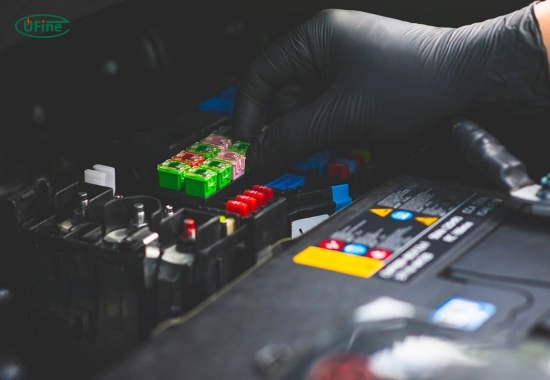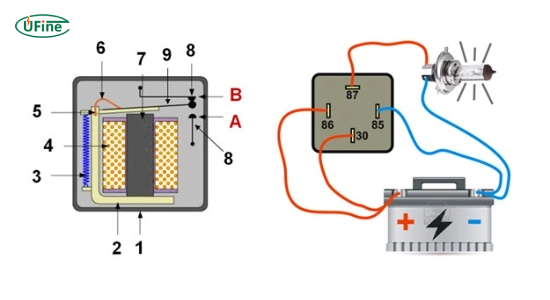Choosing the right battery relay for your vehicle ensures optimal performance and reliability. A battery relay acts as a switch that controls the flow of electricity between the battery and various electrical components. Whether upgrading your vehicle’s electrical system, adding new accessories, or simply replacing an old relay, understanding how to select the right one can save you time, money, and potential headaches. In this article, we will explore the essential factors to consider when choosing a battery relay and common questions and answers to help you make an informed decision.
Part 1. What is a battery relay?
A battery relay is an electromechanical switch that connects or disconnects electrical circuits based on certain conditions. It plays a vital role in managing power distribution within your vehicle. When activated, the relay allows current to flow from the battery to components such as lights, radios, or other accessories. Conversely, when deactivated, it cuts off the power supply, protecting your battery from draining.
Key Functions of a Battery Relay
- Power Management: Controls the distribution of power to various components.
- Safety: Prevents overloading and protects against short circuits.
- Convenience: Allows for remote device activation without requiring direct battery access.
Part 2. Why do you need a battery relay?
Understanding why you need a battery relay is essential for making an informed choice. Here are some reasons:
- Prevent Battery Drain: A relay helps manage power consumption by cutting off power when it’s not needed.
- Enhance Performance: By regulating power flow, relays can improve the efficiency of electrical systems in your vehicle.
- Simplify Wiring: Relays can simplify complex wiring setups by centralizing control over multiple devices.
Part 3. Types of battery relays
When it comes to selecting a battery relay, knowing the different types available is crucial:
- Standard Relays: Commonly used in automotive applications for basic on/off functions.
- Latching Relays: These maintain their state even after power is removed, which is helpful for memory functions.
- Smart Relays: Equipped with microcontrollers that offer advanced features such as programmable settings.
Part 4. How does a battery relay differ from other types of vehicle relays?
Battery relays serve specific functions distinct from other vehicle relays, such as turn signals or horn relays.
Key Differences
- Functionality: Battery relays primarily manage power distribution from the battery to various components, while other relays often control specific functions like lighting or signaling.
- Current Handling: Battery relays typically handle higher currents than many other vehicle relays due to their role in powering significant systems.
- Activation Mechanism: While most vehicle relays are activated by direct control signals (like switches), battery relays may also be controlled by timers or sensors, depending on their application.
Understanding these differences is essential when selecting the appropriate relay for your vehicle’s needs.
Part 5. How to determine the right specifications?
Choosing the right specifications for your battery relay involves considering several factors:
Voltage Rating
The voltage rating should match your vehicle’s electrical system (typically 12V or 24V). Using a relay with an incorrect voltage can lead to failure or damage.
Current Rating
The current rating indicates how much current the relay can handle safely. It’s essential to choose a relay with a current rating that exceeds the maximum load of your devices. For example, if you’re powering multiple accessories that draw 30 amps, select a relay rated for at least 40 amps to ensure safe operation.
Coil Resistance
Coil resistance affects the amount of current required to activate the relay. Lower resistance means less current is needed for activation but may also lead to higher heat generation. Balancing these factors based on your specific application and usage patterns is crucial.
Part 6. What features should you look for?
When selecting a battery relay, consider these features:
- Durability: Look for relays made from high-quality materials that withstand harsh conditions. This includes resistance to moisture and corrosion, which can significantly impact performance over time.
- Weather Resistance: If you use the relay in exposed areas, ensure it has weatherproofing features such as sealed housings or gaskets that prevent moisture ingress.
- Ease of Installation: Some relays come with plug-and-play designs that simplify installation. Check if they include mounting hardware and clear instructions for installation.
Part 7. How to install a battery relay?
Installing a battery relay can be straightforward if you follow these steps:
- Disconnect the Battery: Always start by disconnecting your vehicle’s battery to prevent any electrical shocks.
- Identify Relay Location: Choose a suitable location near your battery and electrical components to protect them from physical damage and moisture exposure.
- Connect Wires: Follow wiring diagrams specific to your vehicle and connect wires according to their functions (input/output). Make sure to use appropriately sized wire gauges for safety and efficiency.
- Secure the Relay: Use screws or brackets to secure the relay in place so it won’t move around during operation.
- Reconnect Battery: Once everything is connected and secured, reconnect your vehicle’s battery and test the system by activating connected components.
Part 8. Common mistakes when choosing a battery relay
Avoiding common pitfalls can save you from future complications:
- Ignoring Specifications: Always check voltage and current ratings before purchasing; this ensures compatibility with your existing systems.
- Overlooking Quality: Cheap relays may save money upfront but could lead to later failures due to poor construction or materials.
- Neglecting Compatibility: Ensure that the relay is compatible with your vehicle’s electrical system and accessories; using mismatched components can lead to malfunctions or damage.
Part 9. Maintenance tips for your battery relay
To ensure longevity and optimal performance of your battery relay:
- Regular Inspections: Periodically check connections and wires for wear or corrosion.
- Clean Terminals: Clean terminals from dirt and grime to ensure good conductivity.
- Test Functionality: Use a multimeter occasionally to test if the relay operates correctly under load conditions.
Part 10. FAQs
-
What is the difference between a standard and a smart relay?
Standard relays perform basic on/off functions without any advanced features, while smart relays come equipped with microcontrollers that allow for programmable settings and enhanced functionality tailored to specific applications. -
Can I use any relay for my vehicle?
No, choosing a relay that matches your vehicle’s voltage and current requirements is crucial. Using an incompatible relay can lead to system failures or damage due to inadequate handling of electrical loads. -
How do I know if my battery relay is failing?
Signs of a failing relay include inconsistent operation of electrical components (like flickering lights), burning smells indicating overheating, or visible damage on the relay, such as melted plastic or corroded terminals. -
Is it necessary to use a fuse with my battery relay?
Yes, using a fuse adds an extra layer of protection by preventing overloads that could damage your electrical system or cause fires; always select fuses rated appropriately for your specific application. -
Can I install a battery relay myself?
Yes, if you have basic knowledge of automotive wiring and follow proper safety precautions, you can install a battery relay yourself. However, consulting with a professional is advisable if you need clarification on any part of the installation process or encounter unexpected issues during setup.
Related Tags:
More Articles

How to Choose the Best Floor Scrubber Battery for Commercial Cleaning?
Selecting the ideal floor scrubber battery ensures a long runtime, rapid charging, and minimal maintenance for efficient commercial cleaning operations.
Battery for Blower vs Battery for Leaf Vacuum: Which One Should You Choose?
Battery for blower vs leaf vacuum—learn the key differences in power, fit, and runtime to choose the right battery for your outdoor tool needs.
How to Choose the Right Battery for Blower?
Choosing the right blower battery? Consider voltage, capacity, chemistry & usage. This guide helps match the best battery for peak performance.
How to Choose the Best Insulated Battery Box for Lithium Batteries?
Choosing the Best Insulated Battery Box for Lithium Batteries? Discover key factors such as size, material, and safety for optimal protection and performance.
7 Critical Elements on a Lithium Battery Shipping Label
What must be on a lithium battery shipping label? Learn 7 key elements to ensure safety, legal compliance, and correct handling across all transport modes.





